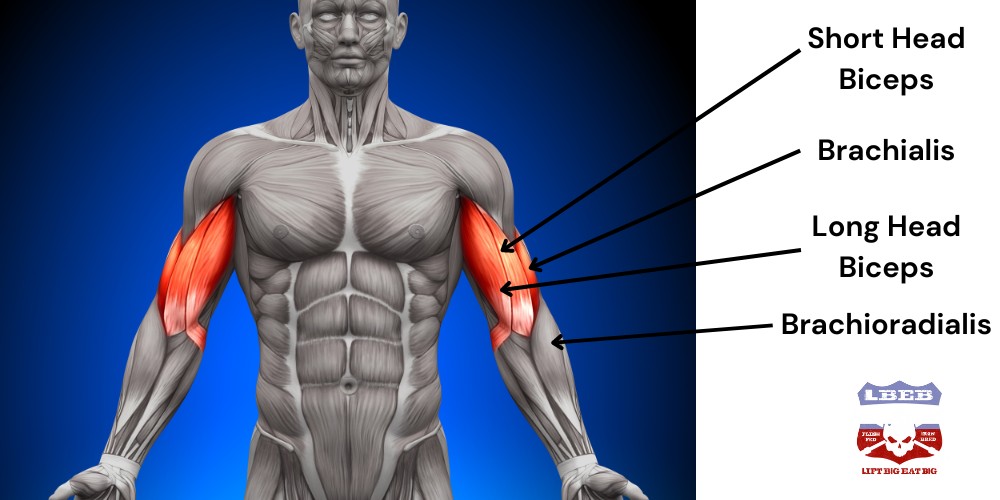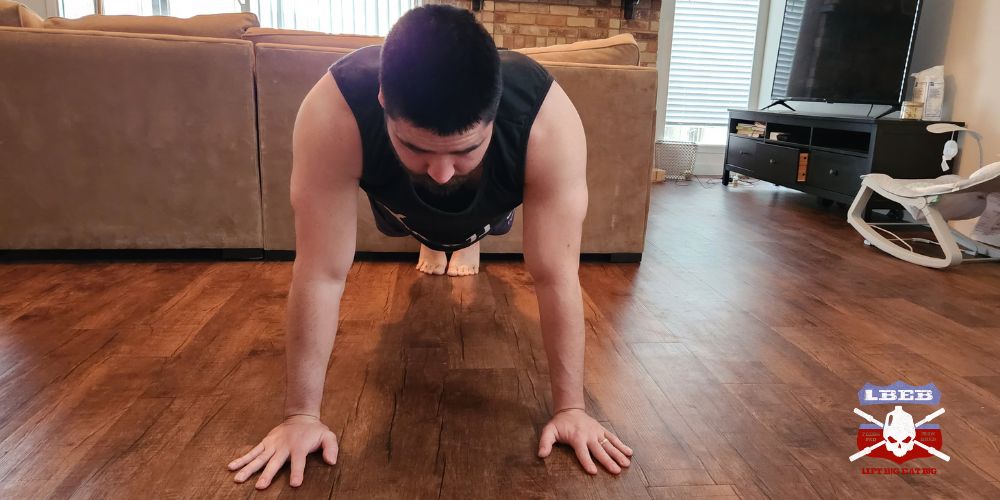A quick search on the internet will lead you to believe that push-ups work the biceps. This is wrong and misleading, holding back your physique progress if you use the push-up in your biceps routine.
While the push-ups elicit minimal biceps activation, they do not work the biceps extensively enough to stimulate muscle growth.
But why don’t push-ups work the biceps when you can feel your arms burn after a high rep set? To understand this, we must know a little about biceps anatomy.
Table of Contents
Biceps Anatomy
The biceps are made of two muscle heads:
- Short head
- Long head

Both heads originate at the shoulder and insert on the radius bone in the outer forearm [1]. The primary function of the biceps is to flex the elbow and supinate the forearm. They also help flex the shoulder. The biceps brachii elicit the greatest muscle activation when the forearm is supinated.
But the brachialis muscle is the strongest elbow flexor and is targeted with a neutral hand position. It originates on the bottom of the upper arm and inserts on the ulnar bone in the inner forearm. Its primary function is elbow flexion [2].
The brachioradialis contributes to elbow flexion and pronates and supinates the forearm. The most significant activation occurs when performing curls with a pronated hand position [3]. Therefore, maximizing biceps growth requires performing elbow flexion with various hand positions.
Do Push-Ups Work Biceps?
The push-ups don’t work the biceps to any significant degree. For example, one study analyzed muscle activation of 12 different push-up variations [4]. They found the regular push-up produced muscle activation of 4.4% of maximum voluntary contraction.
Meaning the push-up only activated the biceps by 4.4% of the subject’s maximum ability to contract the muscle. This makes sense as the prime movers in the push-up are the chest, shoulders, and triceps, which are pushing muscles.
The biceps are pulling muscles and act as stabilizers during pressing exercises. This is further supported in a study showing the biceps activating at approximately 10% of maximum contraction ability [5].
If your goal is to get bigger biceps, then the push-up is not an exercise you should use to train them. Instead, you must target the biceps based on their anatomical function, which is elbow flexion and supination with various hand and shoulder positions.
Best Push-Ups For Biceps

There is no best push-up for the biceps as the biceps are used so little during the movement. But below is the push-up that activates the biceps the most.
Clapping Push-Up
The clapping push-up elicits the most significant biceps activation, likely because you must rapidly flex your elbows to clap in mid-air [4]. Does this mean it’s a good exercise for your biceps? No. Muscle activation ist only part of the complex muscle-building puzzle.
Maximizing muscle growth requires high levels of mechanical tension, either through heavy loading or light loading close to or at failure [6]. Therefore, a mixture of heavy and light biceps curls, hammer curls, and reverse curls will build your biceps.
Summary
The biceps are barely activated during the push-up. They are stabilizers instead of prime movers since the main muscles used in a push-up are the chest, shoulders, and triceps. To get bigger biceps, perform exercises that challenge elbow flexion.
References
1. Tiwana, M. S., Charlick, M., & Varacallo, M. (2018). Anatomy, shoulder and upper limb, biceps muscle.
2. Plantz, M. A., Bordoni, B. (2022). Anatomy, Shoulder and Upper Limb, Brachialis Muscle.
3. Kleiber, T., Kunz, L., & Disselhorst-Klug, C. (2015). Muscular coordination of biceps brachii and brachioradialis in elbow flexion with respect to hand position. Frontiers in physiology, 6, 215.
4. Freeman, S., Karpowicz, A., Gray, J., & McGill, S. (2006). Quantifying muscle patterns and spine load during various forms of the push-up. Medicine and science in sports and exercise, 38(3), 570-577.
5. Alizadeh, S., Rayner, M., Mahmoud, M. M. I., & Behm, D. G. (2020). Push-ups vs. Bench press differences in repetitions and muscle activation between sexes. Journal of Sports Science & Medicine, 19(2), 289.
6. Schoenfeld, B. J., & Grgic, J. (2019). Does training to failure maximize muscle hypertrophy? Strength & Conditioning Journal, 41(5), 108-113.
